The American music industry is founded on the principle that you have an ability to sing. If not then you ability to lip sync is greatly appreciated because then producers can use you as the image for the group/brand as was the case in C+C Music Factory. Zelma Davis was found out to have been lip syncing their hit “Gonna Make You Sweat (Everybody Dance Now)” in the music video to Martha Walsh vocals. In South Korea the process is different. Children from a young age go to audition to train to be an idol. If they are selected then they spend the rest of their childhood and adolescent days training to debut. During this process, they must attend regular school as well as classes for handling the media, acting, dancing, singing and maybe even songwriting. If the trainee has a special skill such as playing an instrument, then they are encouraged to further develop this as it will become part of their image. If not then hopefully, they can find one before they debut as most of their TV appearances will ask about this in their early appearances. Apart from their training, the trainees have no say in how their image will be presented to the public until their debut. The company decides whether they debut as an individual idol or as part of a group. Most group members usually haven’t met each other until they start training as a group to debut. The company’s decisions do not stop there. They employ hundreds of song writers and usually picks and chooses the song in which the group has to sing for their album from them. They even pay for the music video that goes along with their title track. The idols themselves do not start making any serious money until well after they’ve established themselves. So the company pays for everything and in return the idol is under a strict contract with the company. Years of training and hard work is put on display when an idol debut. So the next time you see a k-pop music video remember that.
While the genre of K-Pop music is expanding its reach globally, it is not something that is new in the music market. K-Pop combines the different aspects of music from ballet to Broadway and repackages it to reach its target audience. By including flashy dance sequences and catchy show tune lyrics, the South Korean music companies are able to draw in fans to help support their artists. Chuyun Oh suggests that with the dance sequences reflecting different genres, genders and races, the “transnational dance” enables multicultural communication through their music. The communication through their music is misleading as the country itself struggles with embracing multiculturalism and the artists themselves are not diverse. In the midst of growing globally, music companies have started expanding to international markets and acquiring international talent but controversies in management shows an unprepared readiness for diversity.
With the intention to examine the inconsistent messages of multiculturalism between music and society, this paper will expound on the differences presented through music videos, the news and fan accounts. In the end this paper will explore the development of multiculturalism in a homogeneous society and how the economic changes are bringing forth an unexpected diversity that can be connected to the globalization of K-Pop and an increased global presence.
YouTube started out as a way for a guy to upload videos of his cat. Now it is used for any kind of video you can imagine. From learn how to pick a lock or build a chair to learning how to code and music videos. You can find just about anything on YouTube, it has become the video google platform. K-Pop music companies use it to upload their artist(s) music videos so that they may have a global outreach. It is one of the reasons K-Pop has become so accessible. Fans flock to YouTube when teaser videos are released and when the music video is released, they re-watch it countless times to help increase the view count. The higher number of views, means the more notice their artist will attract. The fans have also taken to YouTube to upload Korean variety TV shows when their artist is likely to appear on the show and put subtitles to it so that fans from a different country can enjoy see them in a different light. Videos from popular shows like Weekly Idol and Happy together end up translated and put on YouTube. Mostly under different names as they are more likely to be taken down if the official name is used. Having these videos allow fans to have access to their idols 24/7. The fans especially look for FANCAMs (fan camera) that are taken during a concert. That way they can feel as if they were there too. Even if they know the songs, the videos help them see the remixes, and social interaction that happens during a concert that is not likely to happen because the artist may never visit their country/state(or province)/city. Fans have even flocked to YouTube to upload lyrics videos of the artist(s) songs that include the Korean, Romanization (Korean written in English instead of Korean characters) and English versions so that it can help their fellow fans follow along and learn the song. The music videos that are released online also have a fan chant that accompanies the song. Fans who are part of the fan cafe (a place where Korean fans gather and get information about their artist) have access to the chant and will usually upload a video to spread the word. This helps the all the fans learn the chant so that when they see the artist live they can chant along with the song. YouTube has made the connection between artist and fan more personal.
Classify your artifact. Classifications are helpful to understanding your artifact. Once you’ve placed your particular artifact in a larger group, you can make connections between your artifact and the general characteristics associated with that group. In addition, sometimes describing your artifact from within a larger, more generalized framework makes it easier to identify important features. Usually, an artifact can classified in various ways and placed in a number of groups.
1. How do you classify your artifact? In what groups can you place your artifact? What connections can you make to other artifacts in the group?
CD’s are the part of the evolution from The Walkman to The Discman in 1984. They are a type of portable music that is still available in today’s technologically advanced mainstream. It started off expensive and then became a common household item that is relatively cheap and now its being pushed out the door but in South Korea, it’s not ready to give up the fight. It may be a relic in some places but it has become a collectible and piece of art in the K-Pop world.
2. Identify points of similarity between your artifact and others. Then identify points of difference with other artifacts. How is it similar? How is it different?
CDs are used to hold music, just like an iPod or an MP3 player available. It can hold up to 80 minutes of music or 700 MB of music files which limit the amount of music available to you if you’re a music lover. To use it, you would need a CD player, one that is portable or attached to a radio/boom box. To give yourself a range of music to listen to, you would need to carry extra CDs and that would most likely be in a CD case. On the other hand, iPods and MP3 players can carry 16-120 GB of music giving you several days worth of music. They can be arranged in playlists and can be sorted by genre, year, artist, and title. Since all the files would be on the device, you wouldn’t need to carry around extra music in case you feel the need to listen to something differently. Your music would be protected unless you damaged the device unlike a CD which can get scratched and skip over songs. You music device may contain your library of music but it doesn’t incorporate all the items you get when you buy a CD. For one, you get a book that has the lyrics for the song as well as photos of the artists. The book tells you the theme or concept of the album where as on your music device, you just get the picture and if you’re a person who likes to keep their files organized (like me) you would have to spend time looking for the lyrics for your songs to include them.
Create an analogy or metaphor for your artifact. Analogies and metaphors are ways of making connections between your artifact and other artifacts (anything goes… items of clothing, locations, holidays, texts, products, etc.). Be creative here… try to make (il)logical leaps.
3. What metaphors or analogies suit your artifact? (Explain if needed)
CDs are decision traps. You buy them, glad to have the latest songs from your artists, but once you’ve made the content digital, what do you do with them? Do you put it away, never to be seen again? When you see it again, do you throw it away or keep it in storage? Do you put it on display and where will you find the room to? Do you resell it at a cheaper (or expensive) price to someone else?
CDs are art. We have gotten creative in the way we label things. We stamp CDs with an image that matches the contents and if you put your collection together without the cases, you’d be surprised at how many different pictures and themes you have on your CDs.
CDs as collectibles. CDs are becoming a thing of the past. As we make our files more digital, they become a tangible sign of how things used to be. Just like the record who is making a slight comeback into popularity.
Examine cultural narratives. Cultural narratives are common story lines used throughout culture, telling how things typically happen. Once you identify cultural narratives that apply to your artifact, you can examine them for assumptions and stereotypes. For example, stereotypes (or rigid, generalized ideas about the character and behavior of people with certain identities) are a kind of assumption (or set of assumptions). As with cultural narratives, you may think you are not affected by these assumptions and stereotypes. However, their pervasive presence in the culture means that everyone is affected by them. Naming these assumptions stereotypes can aid you when describing the impact of culture and values on your particular artifact (or your artifact’s impact on culture and values).
The assumptions operating in cultural narratives found in movie plots and song lyrics also get played out in social practices and social institutions. Social practices are shared, habitual ways of doing things. A variety of guidelines exist for the social practice of dating, for instance: who will initiate the date, who will decide where to go, who will pay. Social institutions are larger, more formalized organization the direct our shared social structures. Questions to explore (pick and choose):
4. How is your artifact characterized? (How do people/media/groups characterize it?)
Some people view it as thing of the past. When Apple came out with the iPod, some felt the CD was an unnecessary to have for music. Others see it as a way to sell their collectibles of rare and out-of-print music to those who still buy CDs. Many international fans of K-Pop and J-Pop (Japanese pop) see it as a way to bring the music to them. In the early days of the Hallyu wave, the music was only available to international fans via CDs. Now that iTunes have started adding international artists from around the world, the CDs sales may start to decline, but the fans will most likely still continue to buy them. Especially when the music company offers signed albums or a chance for a meet and greet with the artist when they sell them.
5. What cultural narratives govern your artifact?
When CDs first came out if gave everyone the freedom to lighter way to carry their music around. It became popular, so when you used one, you were part of the tech savvy people. Now it can be said that you’re not up-to-date. That you’re stuck in the past. It can also mark you as a supporter of K-Pop. If you have the latest album, you’re offering your artist support.
6. What assumptions, stereotypes, habits, social practices, and institutions frame your artifact?
K-Pop fans are seen as fans who would buy everything related to their artists. From either buying all the artists’ albums or all the different versions of the same album to help boost the artists’ sales. If you have the songs but not the album, you most likely downloaded it from somewhere and didn’t pay for it.
7. What doctrines or practices affect your artifact? (Or, what doctrines or practices you’re your artifact affect?) Political parties and platforms? Religious? Ideological? Which ones? Are there cultural “rules” and practices? Which?
When going to events to support their artist, they must have the latest album and be able to show it to gain entrance to TV recordings or fan events. If not then it comes down, to a copy of their receipt for a digital purchase. If the group is new, then any album purchase is just about okay for admittance but eventually, the new album will be required as they gain more popularity. The artists’ success on the music shows may also depend on the sales of their album and fans can show their support by buying it.
8. How does your artifact affect culture? How does culture affect your artifact?
CDs affected the music scene in offering a way to carry around albums from artists in a lighter form. It also became a way to promote the artists’ music since it was easier to write a CD than to write on a cassette tape. With the different ways we have developed to create a cover on CDs, we have even changed how they look. South Koreans took CDs in a different marketing direction than America by using it to include more than just the CD and book. They’ve used the book to showcase themes/concepts and lyrics and hold a trading card (a photo of one of the artist(s)) as well as promote their own digital music sites. They have also created different versions of the same CD as well as repackaged older songs.
When I was thinking about our assignment for artifacts related to my topic, I thought about using words. Words every K-Pop fan learns as they become immersed in the exciting world of K-Pop and in turn they start using with other K-Pop fans. But then I wondered, how would that work? Would they have to be relevant to only today’s audience? Would they be words that are still being used and their meanings have changed? In English, we are constantly modifying the way we speak and changing the meaning of words. Take the word gay for example. This word started out a meaning joyful, carefree and happy. In the 17th century it changed to mean addicted to pleasures. In the 19th century the meaning changed again. It now mean a woman who was a prostitute and a gay man was man who slept with a lot of women, usually prostitutes. It wasn’t until the 1920s and 1930s that this word changed to mean homosexual. As you can see the word is an artifact of sorts and at the same time it represents the different cultures that used the words. Just like any subject area, even K-Pop has its own jargon that the fans used. The K-Pop jargon reflects the Korean culture while at the same time separates the fans from the non-fans. In this post, I’ll explain some commonly used words.
- Oppa (oh-pa)/Hyung (h-young) – These words are used to refer to male artists who are older than the speaker. Oppa is what females would say and hyung males. They are used either as terms of endearment or to show a close relationship. Fans use them to flirt and show affection.
- Noona (nu-na)/Unnie (uh-ni)- The same as Oppa/hyung except used to refer to female artists who are older than the speaker. Noona is used by males and Unnie used by females.
- Aegyo (eh-g-yo) – when the artist is acting cute and showing their charms. This is done by both male and female artists
- Comeback – When the artist returns with a new project (song/album, drama, etc.)
- Sasaeng – a super obsessed fan who goes over the top when showing their love for their artist (e.g. following them around in a taxi all day, stalking, etc.)
- Daebak – awesome, wow, great
- Maknae – the youngest (whether in a situation family or in terms of the group members age)
- All-kill – when an artist/s reach number 1 on all (Korean) digital music charts
- Netizens – internet citizens
- Skinship – when the artist shows affection to its members or other artists
- Idol – what most k-pop artists are referred to since they are trained to be performers and uses their looks and appearance to earn money (opinion of the Korean public)
- Artist – those who use their musical talent to add depth and meaning to their music. also used interchangeably with idol. (has more respect than idol from the Korean public)
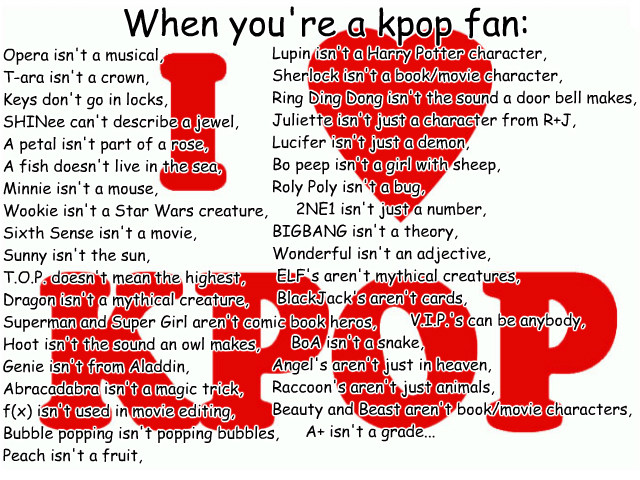
In the last couple of classes we have talked about artifacts that relates to our topic. I had several things and ideas that I thought fit the bill. For one I wanted to talk about plastic surgery and how it has become a cultural norm for South Korean. In the US plastic surgery is used more for reconstruction because of an accident or to hide/get rid of a what the person considers a defect. On the other hand there are people who use it for the sole purpose to look more beautiful (cosmetic). In South Korea it used for those purposes but more often to look beautiful than reconstruction. The most common types of plastic surgery tend to be the double eyelid, jaw reduction, eye widening, rhinoplasty, forehead and chin augmentation surgeries. By having these surgeries, Koreans are closer to meeting the ideal beauty type that is emphasized by their media. Their media not only portrays their own actors and singers but also western actors and singers. The influence of western culture has also impacted their beauty industry which causes conflict images of what is considered to be beautiful. Plastic surgery has become part of the Korean culture and grown with it. Today’s children are given gifts of plastic surgery when they graduate middle school and most of them actually use it. They will get their double eyelid surgery or their nose fixed. Because to them, having a small face with double eyelids is attractive as well as being ‘white’. White in the sense that the paler you look, the more beautiful you are. The cheap cost might also be a factor. What can cost you upward of $10,000 in the States may just be under $3000 in South Korea. Just take a look at the contestants for Miss Korea in 2013. Some people believe they all look alike and it is because of plastic surgery.
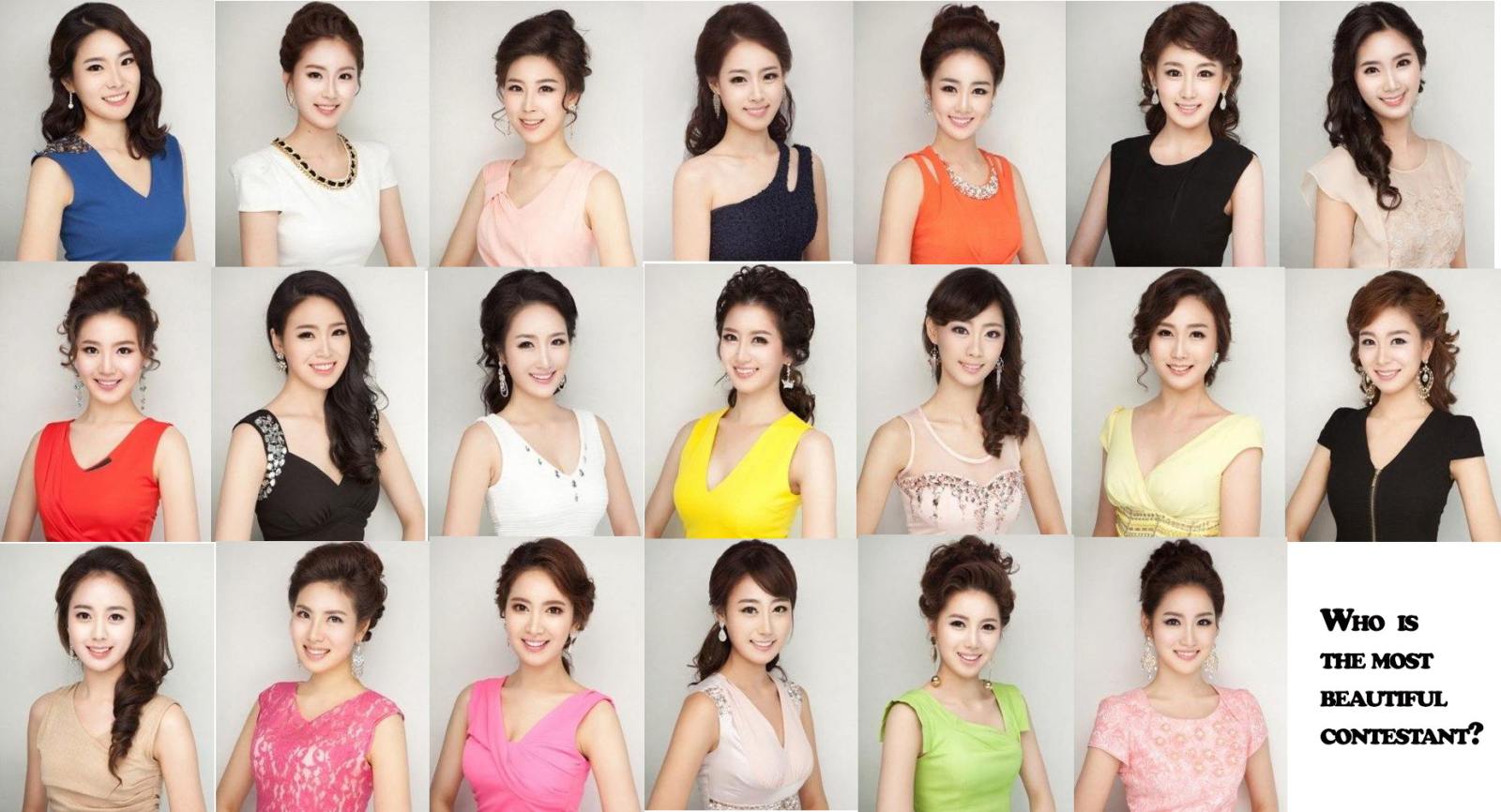
Another artifact, I would like to bring up is CDs. In today’s digital world, CD’s are going out of style. Its just so much simpler to download the song than to have the CD, or buy the Vinyl version as they are making some sort of comeback. K-Pop fans are full supporters of their artists. They will go to the music shows where they perform, attend show recordings in hopes of cheering on their groups. They also help the artists by buying their albums. Whether its for the hope of getting it signed or to help boost their numbers so that they can win on music shows, fans by their all their albums even if it only has two songs on it (a mini album). The more practical fan would wait until an album is released with more than two songs but others buy them as the artists may release three of four mini albums before releasing a regular full length album. Every time the artist releases a new song (if they aren’t on the same album) a new CD with the song comes out. The CD design will match the concept that the artist is doing for the song and most times there is a card of either one of the the members or in the case of a solo artist the artist them self inside the case. This in turn causes the fans to buy more than one copy of the album in hopes of getting all the different members or their favorite member for groups and all the different poses for a solo artists. The company promoting the artist may also have individual member albums in which each member has their version of the album. The albums themselves are also used as a way to get into show recordings with the artist as the fans must show their copy of the album that is being promoted to participate. The first image below is what a person is likely to encounter when they go to K-Pop store to buy a CD. The second picture reflects the number of albums an artist may have released including mini albums. The third picture reflects Super Junior’s ‘This Is Love’ album that was released as the members’ version.
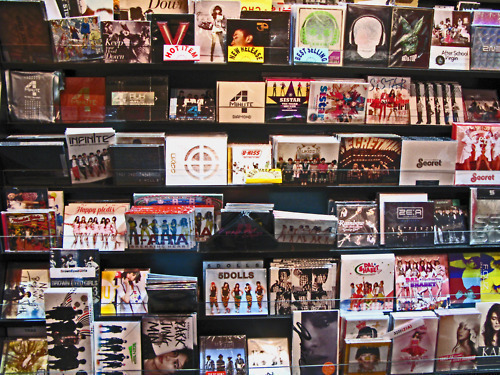
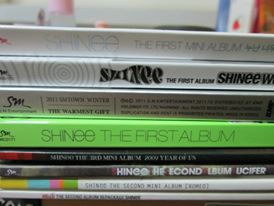
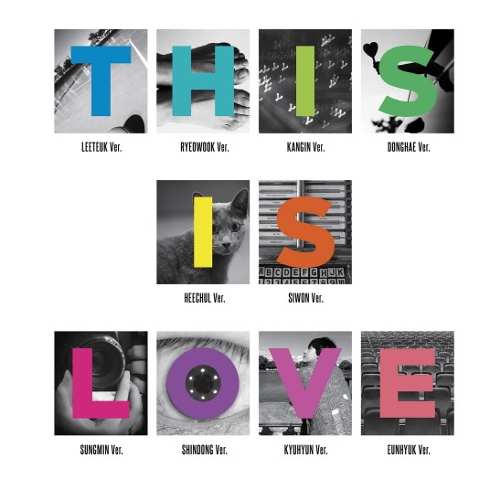
A third artifact would be fast food delivery. When you think about fast food delivery, you probably think about having pizza or Chinese food delivered to you house. South Korea has taken it one step further. In South Korea just about any type of food can be delivered. From fast food chains like McDonald’s and Burger King to traditional Korean meals, anything you can order can be delivered. This service is included at some restaurants. What they do is hires motorcycle drivers who then take your order and deliver it to you, whether its to your house or a spot by the Han River. If your meal comes with dishes such as plates or bowls, when you’re finished you can leave them outside the door to your resident and the driver will come by an pick it up. It is part of the service and doesn’t cost you anything extra. You can see this service live in many K-dramas for as the characters either work as a driver or orders the food. These services are mostly offered 24/7 and is convenient for those who work irregular hours.


All this talk about South Korea reminds me of the time that I have spent there in Seoul. I did not experience any discrimination and in fact I would even say that the people I have encountered seemed to do the opposite. They showed me what a great place South Korea is. I have even attended events in which being a foreigner was a plus as they let me in early or they made concessions for me because they believed I would have trouble understanding what was going. The people were friendly and helpful when I had to order or navigate the subway system. That does not mean that I did not have any bad experiences while I was there but they were things that could have happened in any country. What helped me enjoy my time there was being able to participate in events that were only for foreigners. The Seoul tourism office created a group called Seoul mates in which foreigners who are in the country from 3-6 months up to a year were invited to attend events for free as long as they wrote about it in a blog. You would be able to attend different festivals held during the year as well as performances. This way you become more than a tourist, you started to become part of the culture.
This got me to think about the programs we have in place for our tourists. Besides offering tours in their native language, do we do anything else to promote our culture and events? Do we say, hey if you’re going to be here during this week, you could attend it for free as long as you write about it or at a discounted rate? I know we don’t need help in the tourist area but after traveling for two years, they way we approach tourism in the US is very unattractive. I spent one night in Budapest and it was absolutely amazing. Why? Because, when I got off the plane, there were all these brochures advertising ways to get around the city and discounts for foreigners at local establishments. I managed to sneak in a trip to the spa because they had a 25% discount for foreigners. When I looked up Fort Lauderdale tourist attractions there are several websites that pop up and most of them are connected to Trip Advisor, which doesn’t help if you only have negative reviews on the attraction. Maybe they just expect the tourists to go shopping as Sawgrass Mills is frequently mentioned.
As I have mentioned in my last post, I needed to take a look at Korea before they became tech giant and how it is changing now. In looking through South Korea’s history major events such as the Japanese occupation in North Korea and the US in South Korea, the military regime, the fight for democracy and their rise to be an industrial power come up. But something else seems to pop up as well: the word homogeneous. South Koreans consider themselves to be a homogeneous country but depending on who you ask the meaning will be different. If you take the word at face value, you would probably assume that South Korea is only made up of people of Korean descent. While this is not true (and it would be hard to argue it being true since we all know what happens when two countries occupy the same territory) the phrase is used to mean that South Korea is an ethnically and racially homogeneous country. While it could be a point of pride in only having a single race in the country, it has led to many discussions on the rise of immigrants and how South Korea is becoming a multicultural country. Some believe that the country needs open-nationalism to embrace other people and some believe they should not allow other races in the mix. These conflicting views has lead to some immigrants experiencing discrimination in the work place and in public. It is not uncommon to see signs that ban non-Koreans from entering an establishment as there is no anti-discrimination law. On the other hand laws such as The Act to Support Multicultural Families have come into effect and helps those whose family dynamics include foreign spouses. As time goes on, the migrant population is going to keep growing and the Korean government is going to have to step in to find a way to include other cultures in their way of life.
Last week, we were asked to read “Backpacks vs. Briefcases: Steps Toward Rhetorical Analysis”. I read it and it started an idea rolling in my head on how e-mail etiquette has changed. E-mails because, it has become a pet peeve of mine, when I e-mail someone asking them several questions and when they respond, they have only answered one. I wanted to find out what the rules were and if they had somehow changed while I wasn’t looking. Turns out they didn’t but still people don’t follow those rules and there my start at rhetorical analysis on e-mail stopped. It was helpful for me to try out the process on something unrelated to my topic and see how far I could go. When I got to applying the rhetorical analysis on my topic, I found several different angles I could take but one caught my attention the most.
In looking for information on my topic, I stumbled upon another side to my topic that was not easy to see until I found the book “The Korean Wave: Korean Popular Culture in Global Context” by Yasue Kuwahara. My plan was to explain how the South Korean culture was affected by the Hallyu wave of K-Pop and K-drama but that could be relatively explained in a couple of pages. In the book, there is a chapter on Nostalgic Desire and Colonial memory which sparked my memory on an article I read about how South Korean fans felt about international fans. Then I realized that I could expand my topic to include South Korea’s rise as a Tech Giant and how with the Hallyu wave they are perceived on a global scale. In finding out more, I am realizing that while I may know more about K-Pop as it is today, I need to look back into its history and how the three leading entertainment companies (SM, YG and JYP) are on top. That in turns leads to finding out more about the growth of the country and its people. We’ll see what other information goodies I can find, that doesn’t lead to a Youtube binge on Korean variety shows and I’ll share them next week.
From my previous posts you can tell that I love K-pop. But K-pop is what started the ball rolling on my interests in South Korea. From K-Pop, I transitioned to K-dramas. But that transition was not smooth from the beginning which is why, I’m surprised at myself that I love that genre of TV shows. K-Dramas are mini series unlike the American counterpart which are TV series (like the Big Bang Theory, Criminal Minds, etc.). They mostly have 16-50 episodes per show and have no recurring seasons. Unlike K-Pop, with their flash style that is reminiscent of American pop, K-dramas reflect their cultural values. Usually each show has an overall theme that matches it genre, but underlying themes like filial piety, respect for elders, etc. are apparent. Those underlying themes reflect the Confucian values that permeate their culture. This can be seen in simple things like the question “how old are you?” or other various sayings with the same meaning that almost always comes up in the show. The reason is due to the fact that in their culture, you have different ways to address people depending on their age and status. For example, if the female lead is older than the male, then he is expected to address her by either noona (older sister/ older woman) or her name with the ssi (shi) ending (kinda of adding, Ms/Mrs.). Another point of interest is the cast of the shows.
The shows usually have their beginner/veteran actors/actresses and sometimes a K-Pop artist. The K-Pop artist will either make a guest appearance or have a role in the show. I know that in America, we have artists that end up in movies or they make guest appearances, but they usually end up being only good at being an artist, not an actor/actress. There are exceptions to the rule and South Korea has also proven that but their exceptions are opposite. Their artists tend to do well in both the dramas and music. It is rare when you find the artist doesn’t do well in the drama scene. This is because, K-Pop artists spend years training before they debut in any area. They train in the aspects required to be an artist and also train in their other interests, which may lead them to acting in a drama. Take the actor Lee Hong-ki for example. He is the lead singer of the band FT Island and has acted in a several dramas and movies. His singing, has reached millions of listeners from all around the world, which has also led them to checking out his acting. From there, its not a hard stretch to end up in k-drama world. The many fans of k-dramas, have created websites upon websites that are dedicated to showing the dramas as their airing and giving suggestions as to which ones you should try watching next. Their dedications and interest in the drama world, has help pushed k-drama to a global scale in which South Korea has reacted to. The South Korean government, has also started pushing k-drama sites as part of their tourist attractions. You can find stores that advertise where famous dramas have been filmed and even the merchandise from the drama can found in store. It has the same if not a bigger following than K-Pop. K-Pop and K-dramas were made global due to the Hallyu wave which in turn helped changed South Korea’s image as just a tech giant. Their image of a tech giant came about as part their recovery from the Korean War as they were rebuilding their country and the country’s growth was astonishing. In next week’s post we’ll see how their growth came about and how it put them on par with other leading nations.
A K-drama suggestion:
https://www.youtube.com/watch?v=ZBGgNOmIYsQ&feature=youtu.be
